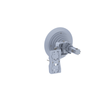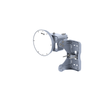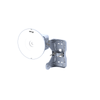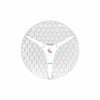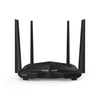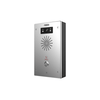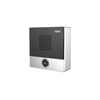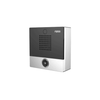Fibre
What is Fibre?
Fibre is a bundle of fibre optic threads made of pure glass, each about the diameter of a human hair. It uses light instead of electricity to carry a digital data signal. Fibre can transmit information at virtually unlimited speed and capacity, delivering superfast speeds.
What makes Fibre so great?
Fibre optic cables have a much greater bandwidth than metal cables. The amount of information that can be transmitted per unit time of fibre over other transmission media is its most significant advantage. An optical fibre offers low power loss, which allows for longer transmission distances.
Below are some advantages and parameters to understand its capacity:
- Speed: Fibre optic networks operate at high speeds – up into the gigabits.
- Economical: Several miles of optical cable can be made cheaper than equivalent lengths of copper wire.
- Distance: Signals can be transmitted further without needing to be amplified or strengthened with the use of signal repeaters
- Size: Fibre optic cables are much thinner than metal wires. They take up less space in the ground.
- Bigger data capacity: Because optical fibres are thinner than copper wires, more fibres can be bundled into a given diameter cable than copper wires. This allows more phone lines to go over the same cable or more channels to come through the cable into your cable tv box.
- Freedom from Interference: Less signal degradation – The loss of signal in optical Fibre is less than in copper wire.
What are the disadvantages of fibre?
- Expensive: The first and the most common disadvantage of Fibre Optics is that it is very expensive to deploy. With the increase demand of preferring fibre optic cables there will be a drop-off in price. But still it is not affordable to use at length only the segment of total is mad u of fibre optic to give some support to the output. Fibre optic itself is expensive no matter but the big problem is that its deployment is also very costly. The connectors and other components are not cost effective and therefore prevent from being installed at large scale.
- Technician: Another important issue in using fibre Optics cables is its deployment. Only a technician could make it possible to deploy the fibre optic cables. A person must be highly proficient about the field of fibre Optics. There are complications posed by the deployment of fibre Optic cables in the form of NICs which can be handled by only a technical staff. If you are going for the fibre Optics network, you are suggested to call a technician.
- Environmental Factor: Environment is very important as it plays negative role on fibre Optic networks. It effects the quality of fibre Optics cables and damage by the bad weather so in the long run they are not tend to reliable. It is necessary to protect them from weather effects by placing them in appropriate place preferably interior environment is suitable than open air.
- Connectors Problem: It happens that after a long time the connectors of the fibre Optics cable start losing. This is not the situation in caps of other types of cabling. As they start losing so is the function of cable as there is more probability of losing data while it travels through the cable.
- Weak: fibre Optics cables are weak in nature as they are making of glass. There are more chances of breakage if misuse or put it somewhere at the insecure place. The parts where connectors are attached are more probable to break while place in unsafe area. Therefore, mostly they are used in close environment especially in-side enclosures or in the walls.
What is fibre internet connection?
Fibre optic Internet is an Internet connection that transfers data fully or partially via fibre optic cables. “Fibre” refers to. the thin glass wires inside the larger protective cable. “Optic” refers to the way the type of data transferred – light signals.
Why should I use fibre?
The number one reason why fibre stands out among leading broadband solutions is its bandwidth capabilities. Fibre optic Internet has the potential to reach gigabit speeds, meaning 1000/1000 Mbps. It does this by harnessing the speed of light through glass tubes that are as thin as a piece of human hair. With fibre you have the speed you need to run all your Internet-connected devices without buffering.
How reliable is Optic Fibre?
No interference: Unlike with copper cables, there's no "crosstalk" (electromagnetic interference) between optical fibres, so they transmit information more reliably with better signal quality. Higher bandwidth: As we've already seen, fibre-optic cables can carry far more data than copper cables of the same diameter.
Pros of Optic Fibre?
Fibre Optic Carries Data Better Over Long Distances
Data can sometimes be affected when it travels long distances. Not even electricity and light are immune to damage from long-distance travel. The signal you get at the other end can be of lower bandwidth. There is a limit to how far copper cables are laid, because beyond a distance of 328 feet, they fail to maintain signal strength. In contrast, fibre optic cables can preserve signal strength for up to 25 miles, which is a lot better than what a cable setup can do.
Electrical or Radio Interference is Not a Problem
Copper conducts electricity very well, although it cannot form a closed system. That means radio or electromagnetic interference can have a negative effect on the signals. For one, it can reduce the strength of the signal, and sometimes even cut the signal completely. Fibre optic lines use glass and plastic in a way that insulates from outside interference, so that the signal stays secure.
Damage is Less Likely
How do I know if I have fibre internet?
Normally you can contact your nearest service provider and find out by them, but some ISP’s are advanced enough to show coverage on satellite view via their website, which saves you much more time by typing in your address and viewing if your area is covered, if it is not, it would be best to contact your selected ISP’s and ask them if it can be installed.
What is needed to install Fibre internet?
Fibre SFP Modules
SFP (Small Form-Factor Pluggable Modules) are small transceivers that provide a network device with a modular interface that the user can easily adapt to various fibre optic and copper networking standards. Switchcom offers a wide range of SFP modules, including both Multimode and Single Mode from 1G to 10G.
How do I select an SFP Module?
When choosing SFP modules, you should consider whether it matches the switch port and the cable you have prepared. If you have multimode cable, then you can choose GLC-SX-MM 1000BASE SFP. If you use single-mode fibre cable, you should select GLC-LH-SM 1000BASE SFP.
Single/Multi mode pigtail
The term ‘Pigtail’ traditionally refers to a short length of Fibre Optic cable with a Fibre Optic connector at one end and bare Fibre at the other. At Switchcom we offer a range of standard Pigtails. These utilize standard Fibre Optic connectors (ST,SC/LC/APC) including 9/125 Single-mode or 50/125 Multimode. G652d, G6527a1, G6527a2.
What is a fibre pigtail used for?
A fibre pigtail is a specific hardware connection used for cable termination. On a fibre pigtail, one end of the wire is simply exposed fibre and the other end has a pre-installed connector on it. Fibre pigtails are commonly spliced onto individual strands of a multi-fibre trunk cable.
Fibre optic cable suppliers South Africa
Switchcom Distribution
Fibre optic cable price South Africa
This will vary between the type of fibre cables you are looking for, but it would start round about R…
What is a single mode pigtail used for?
Fibre optic pigtails are used to terminated fibre optic cables via fusion splicing or mechanical splicing as shown in the picture below. The end of the pigtail is stripped, and fusion spliced to a single fibre or a multi-fibre trunk.
What is a multi-mode pigtail used for?
Fibre optic pigtails are used to terminated fibre optic cables via fusion splicing or mechanical splicing as shown in the picture below. The end of the pigtail is stripped, and fusion spliced to a single fibre or a multi-fibre trunk.
Midcouplers
Fibre Optic Adapters are used to provide a cable to cable connection, bulkhead Inline adapter for Patch Panels or Termination boxes. This coupler provides a solution for extending a current run of Fibre Optic cabling. This coupler is constructed from high-grade plastic and has been designed and engineered for durability and a long life. Simplex or Duplex. Simplex or Duplex. Multi-Mode or Single Mode. Connector Types: ST, LC, SC, LC/APC.
What is the function of fibre Midcouplers?
Fibre optic adapter, also named fibre Midcouplers. it is with fibre interface at both ends and there is a ceramic sleeve inside. It is used for connection and coupling.
Where can I buy fibre Midcouplers in South Africa?
www.switchcom.co.za
2 Core Drop Cable
FTTH Drop Cables are good to use for fibre to the home last mile solution, it has small diameter and light weight, this makes it space-saving and easy to handle, the optical fibre cable is with special structure so it is easy to pull the fibres out from the cables, the FTTH drop cables are ideal to use for direct installation into the houses, suitable for being used in homes and offices.
2 Core Drop cable prices south Africa?
2 Core Drop cable go in South Africa go for more or less R…..
Recommended: www.switchcom.co.za
Fibre patch panel
What is a fibre patch panel?
Fibre optic patch panels are also known as fibre distribution panels. They make it easy to terminate fibre optic cables and provide access to the cable's individual fibres for cross connection. ... One contains the bulkhead receptacles or adapters, and the other is used for splice tray and excess fibre storage.
What's the purpose of a patch panel?
In an enterprise network, a patch panel serves as a sort of static switchboard, using cables to interconnect network computers within a LAN and to outside lines including the internet or other wide area networks (WANs). Patch panels can also be used to interconnect and manage fibre optic cables.
Fibre patch panels suppliers in South Africa
Switchcom Distribution – www.switchcom.co.za
What is a fibre distribution panel?
Fibre optic patch panels are also known as fibre distribution panels. They make it easy to terminate fibre optic cables and provide access to the cable's individual fibres for cross connection. ... One contains the bulkhead receptacles or adapters, and the other is used for splice tray and excess fibre storage.
Which type of fibre optic cable is most widely used?
There are three types of fibre optic cable commonly in use. They are single mode, multimode, and plastic optical fibre or photonic fibre. Transparent glass or plastic fibre allows the guiding of light from one end to the other with minimal loss is the most efficient.
What type of light is used in fibre optic transmissions?
For fibre optics with glass fibres, we use light in the infrared region which has wavelengths longer than visible light, typically around 850, 1300 and 1550 nm. Why do we use the infrared? Because the attenuation of the fibre is much less at those wavelengths.
How does Fibre at home work?
Fibre cables run from the exchange to the cabinet on your street, which then connects to your home via the ol' copper phone line. ... Fibre-to-the-home (FTTH), meanwhile, means the entire line is fibre from the exchange all the way into your building.
What is a good Fibre speed?
25 – 50 Mbps: A taste of what fibre is capable of (typically suitable for up to 5 devices) With the 25 to 50 Mbps option you start moving into the possibilities that fibre has opened up for internet users like 4k video streaming for 1 device at a time.
Does Fibre work without electricity?
Fibre services will only work as long as the ONT (Optical Network Terminal) and your Router are powered on. This means without an additional power source you won't be able to use your Fibre service during a power outage.
How does fibre to home work?
Fibre to the home or premises (FTTH or FTTP) means your fibre internet connection goes straight into your home. If your home isn't already set up to receive a fibre connection, you may need your ISP to drill holes or even dig nearby. This is the holy grail of fibre connections.
What is the difference between single mode and multi mode fibre optic?
Multimode fibre has a relatively large light carrying core, usually 62.5 microns or larger in diameter. ... Single-mode fibre has a small light carrying core of 8 to 10 microns in diameter. It is normally used for long distance transmissions with laser diode based fibre optic transmission equipment
What is the difference between 1310 and 1550?
Multimode fibre is designed to operate at 850 and 1300 nm, while singlemode fibre is optimized for 1310 and 1550 nm. The difference between 1300 nm and 1310 nm is simply a matter of convention, harking back to the days when AT&T dictated most fibre optic jargon.
How far can single mode fibre go?
According to the above form, we can clearly see that transmission distance varies greatly. At different transmission rate, the distance changes. Distance of single mode fibre can reach 40km at the speed of 40gigabit Ethernet, and it will be 10km with the speed of 10gigabit Ethernet
Which is faster single mode or multimode?
Single mode cables are designed to carry light directly down the fibre. ... Compared to the multimode fibre, the single mode patch cords carry a higher bandwidth, but it requires a light source with a narrow spectral width. The single mode gives a higher transmission and up to 50 times more distance than the multimode.
What is the difference between simplex and duplex fibre?
Source — Simplex fibre optic cable uses only single one strand of fibre while duplex fibre cable uses a pair of fibre. Transmission Direction - Simplex fibre optic cable is one-way transmission mode while duplex fibre cable is bi-directional transmission mode
What is the fibre color code?
Fibre colors will be blue, orange, green, brown, slate, and white. Fibres are identified by tube color/fibre color. Blue/White is the white fibre in the blue tube. Tight buffered distribution cables with 12 fibres or less will be colored according to the chart under a single jacket.
Why don't we use fibre optics everywhere?
Fibre-optic cables are difficult to tap because they don't emit signals that can be monitored. They are very secure. Fibre optics is faster than most other transmission mediums. The signal has a constrained loss rate, which means that very little of a signal is lost over rather long distances.
What is acceptable dB loss for fibre?
For singlemode fibre, the loss is about 0.5 dB per km for 1310 nm sources, 0.4 dB per km for 1550 nm. (1.0 dB/km for premises/0.5 dB/km at either wavelength for outside plant max per EIA/TIA 568)This roughly translates into a loss of 0.1 dB per 600 (200m) feet for 1310 nm, 0.1 dB per 750 feet (250m) for 1300 nm.
How do you test fibre?
The most accurate way to measure the overall optical loss in a fibre is to inject a known level of light in one end and measure the level of light at the other end. This measurement done with an optical light source and power meter requires access to both ends of the fibre.
Is Fibre optic light dangerous?
First, most fibre optic links pose no eye damage danger. Second, there are other dangers that you must be concerned with to install or use fibre optics safely. ... The expanding light from fibre also means the eye cannot focus it on the retina, further reducing the risk of damaging the retina.
Is fibre optic light visible?
The wavelength of visible light ranges from about 400 nanometers (blue) to 700 nanometers (red). A nanometer is a billionth of a meter. Longer wavelengths than red are called "infrared" and are not visible to the eye. Most fibre optic systems carry wavelengths of 850, 1,300, and 1,550 nanometers.
Which is cheaper single mode or multimode fibre?
Single-mode fibre often costs less than multimode fibre. ... While the OM3 or OM4 multimode increase 35% in cost for SFPs. The single-mode optics are more expensive, but the labor costs of replacing the multimode are significantly higher, especially if those followed OM1—OM2—OM3—OM4How can you tell if fibre is single mode?
Single-mode fibre optic cable has a core of 8 to 10 microns. In single-mode cables, light travels toward the center of the core in a single wavelength. Multimode fibre optic cable has a core of either 50 or 62.5 microns.
What does dB loss mean?
In telecommunications, insertion loss is the loss of signal power resulting from the insertion of a device in a transmission line or optical fibre and is usually expressed in decibels (dB).
How do you calculate dB loss?
The actual equation used to calculate dB is dB = 10 log ( ratio of measured power / reference power). -30 dB is a ratio of 1/1000, (loss), etc. When the two powers are equal, dB = 0, a result of the log scale used in dB but a convenient value that's easily remembered.
How do I know if my fibre optic cable is broken?
If a lot of red light is visible, the connector is bad and should be replaced. If you look from the other end and see light coming only out of the fibre, that indicates a good connector. If the whole ferrule glows, it's bad. OTDRs can determine the bad connector if the cable is long enough.
What is power meter testing for fibre?
An optical power meter (OPM) is a device used measure the power in an optical signal. The term usually refers to a device for testing average power in fibre optic systems. ... On the display unit, the measured optical power and set wavelength is displayed. Power meters are calibrated using a traceable calibration standard.
What are the disadvantages of optical Fibre?
Disadvantages of Optical Fibre. Limited Application—Fibre optic cable can only be used on the ground, and it cannot leave the ground or work with mobile communication. Low Power—Light emitting sources are limited to low power. Although high power emitters are available to improve power supply, it would add extra cost





















